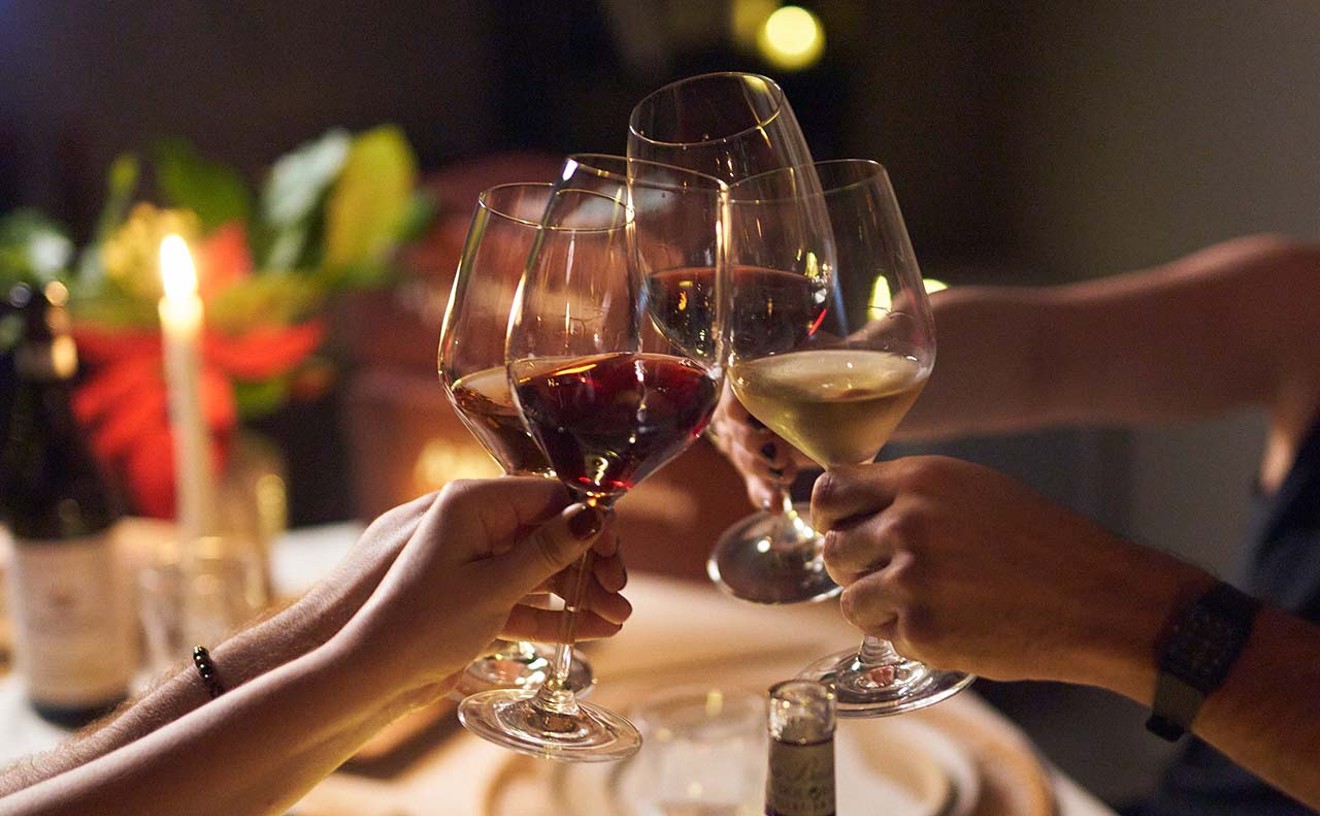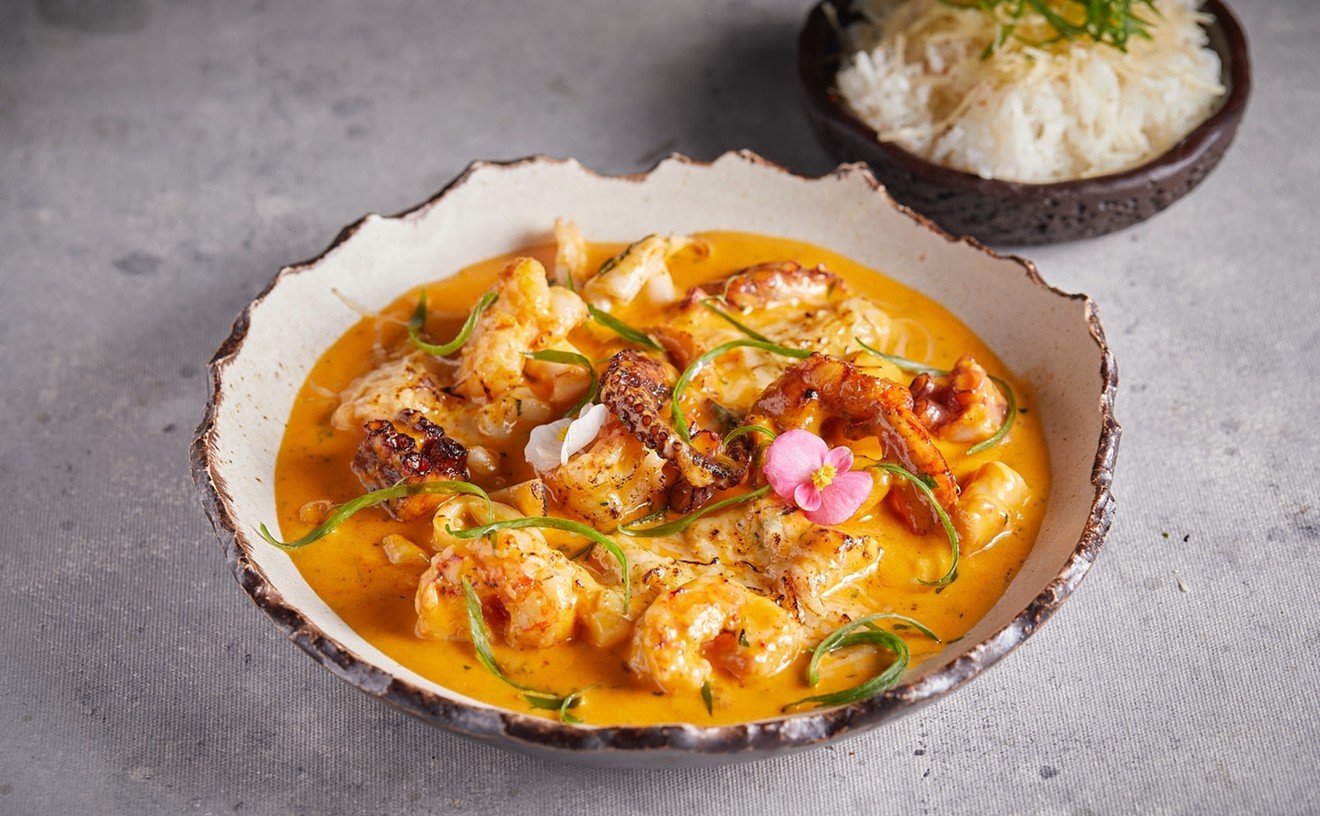My friend, however, was not objecting to the lack of cutting-edge crab empanadas elsewhere. The problem was getting good Cuban coffee.
"You've got to be kidding," I objected, incredulous. For years when I was living in New York City, I'd swilled great cafecitos at the low-rent Cuban bakery a block from my apartment.
"Ah, but did they have a hole in the wall?" she asked. "It doesn't taste right otherwise." And she was not to be budged in her conviction that Cuban coffee ordered indoors was inferior to the identical brew obtained through an outdoor window, and drunk on the sidewalk or in the parking lot.
At first it appeared as though my dining companions and I would get to test my pal's theory when we pulled into the strip mall housing Mambo 5. Most often I have a pretty good idea of a place's ambiance before going for a review because I cruise by to check it out ahead of time. But Mambo 5 was so far west of Miami's regular restaurant rows that I'd picked it purely on the basis of a menu I'd seen more than a year before, when the restaurant opened; it offered what sounded like more creative upscale Hispanic fare than most. Brandade-stuffed piquillo peppers and a "secret wild free range duck and mango sauce" were the clinchers. From the parking lot out front, though, the eatery didn't seem like there'd be much wild duck on the menu. It looked like a Cuban coffee shop.
It was, and it wasn't. Formerly the venerable Zaragozana (named for a famous Havana nightclub/restaurant that dated from 1830; promisingly, the original's motto had been "the fish we serve today slept in the ocean last night"), Mambo 5 is two eateries in one. The very visible one is a casual cafetería with, naturally, a coffee window. But next door, under a sign that just reads "Lounge," there's a dining and dancing venue featuring live Latin music most days -- meaning real bands playing musical instruments, not merely DJs. In fact there were two bands on the Wednesday night of my first visit, both good and both very nostalgic. The first group, which had a female singer, performed some infectiously danceable tunes I'd not heard since the last time I raided my parents' collection of pre-Fidel-era 78 rpm records. The glitzy resto-lounge's large dance floor, empty when we arrived around 8:00, was packed by 10:00, with couples who definitely knew their way around a mambo -- though most seemed young enough that their grandparents had probably danced to the original hits.
Most dancers, though, were not dining. And after a bite of corazon de filete quemado al brandy, my party decided that was wise. The brandy-flambéed filet mignon may indeed have been oak-grilled. It had definitely been grilled for long enough that the ten-ounce steak, which we had ordered very, very rare (in Spanish, so no chance of a language misunderstanding), came shrunk to the size of roughly a size-three child's shoe, and about as tender. But somehow that was not long enough on the flame to burn the raw alcohol taste off the liquor saucing the sad little gray slab.
In fact the wild duck with mango sauce, along with most of the more nuevo-sounding items on the original menu, were no longer listed. But we plowed through, ordering whatever marginally inventive items remained. In the absence of enticing el pollo al hojaldre, for instance, whose description had sounded like a sort of tropical poultry Wellington (the chicken was wrapped, with spinach in béchamel, in a pastry crust, and served in a Vizcaina sauce), we tried Pollo Mambo. The passion fruit sauce that came with the dish had a nicely balanced, tangy sweetness. The breaded chicken breast itself, however, was dried out.
Similarly, the red (pink, really) pepper potion that came with bacalao a la salsa de pimiento rojo was a winner, creamy smooth yet tart like an especially elegant romesco sauce. But the Norwegian cod otherwise had little flavor and less texture; how did the chef even manage to make the fish fillet simultaneously dry and mushy?
Moving on to more homey fare, parrillada de mariscos Mambo #5 featured an assortment of seafood that was unquestionably generous. Two lobster tails and some sizable shrimp had a lovely pronounced wood-grilled taste, too. And while both crustaceans had been cooked too long, a rub in the intensely concentrated marinade on the bottom of the parrillada's platter added moisture and further flavor. Sadly, the sea scallops, so overcooked that they flaked, were bland beyond help. Clams were big and rubbery. Mussels were bigger, with a fishiness that suggested they might have slept in the ocean circa 1830. Squid was unspeakable. The gelatinous, gristlelike rings and chunks might have worked well as athletic innersoles, but were not a workout to which even diners with fortitude would have wanted to subject their teeth.
Arroz negre, a famous "mom's cooking" seafood dish that moms rarely make these days (Spanish rice in squid ink is not exactly something one can whip up after work), had absolutely fabulous rice. My table picked around the dish's nasty dessicated shrimp and squid nubs to consume every last grain.
For dancers desiring fuel, calamares a la Romana would be a smart choice. The fried squid pieces on this entrée-sized appetizer plate were only a bit over-chewy, and their light batter was addictively crunchy. Marinara sauce had zing, and a second side of mango dip was an unexpected pleasure.
A tablón Mambo #5 hors d'oeuvres plate was a mixed success. As opposed to many cooked hams sold under the name, Spanish Serrano ham tasted like the sweet, cured but raw real thing. Spanish sausage was a piquant chorizolike salami. Sheep milk cheese tasted like mild manchego. But the tortilla was inedibly soggy. And croquettes, disappointingly, were just the standard ham sort (and rather heavy ones, at that), rather than the homemade croquetas de Bacalao mousse that are the only croquettes individually featured on Mambo's menu.
Flan was the sole dessert available. It was starchy, leaden, and toothachingly sweet.
On a second visit, to Mambo 5's more humble and very friendly cafetería component, a lechon asado dinner was humongous and reasonably satisfying, as was a special Mambo 5 sandwich of the same pork garnished with a little lettuce and tomato on Cuban bread. However, the pork seemed to have been reheated, after roasting, on the deadly grill next door, rendering it flavorful but just as dried-out as most of the more upscale meal had been. I'm pretty sure, though, that the cafecito did taste better through the window.










